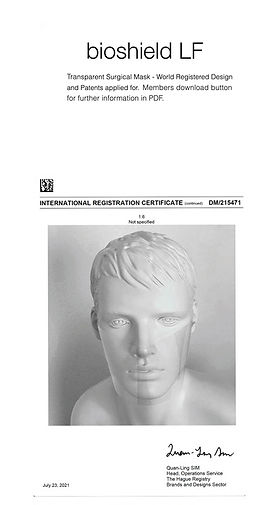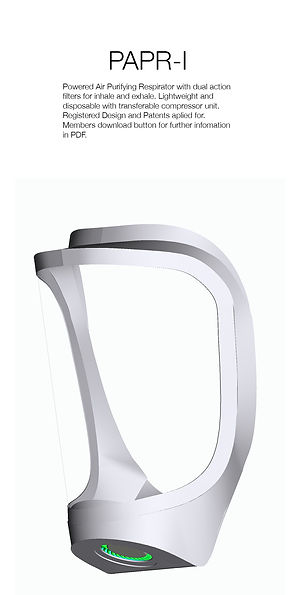
bioshield
Lamina Flow
A modern transparent replacement for the FRSM and technology to replace the FFP2/3 with low cost PAPR-I Lamina Flow alternatives.

Aerosol gas flow technology provides a full range of improved benefits.


Study
The Corona pandemic aroused our interest to study surgical masks and medical respirators, what they are used for and how well they perform.
'Undesirable Side Effects in Everyday Use': https://www.ncbi.nlm.nih.gov/pmc/articles/PMC8072811/
In each of these studies - which is a small fraction of that published, there is a high percentage of harm being caused to essentially fit and trained health care workers.
Summary
The common TypeIIR surgical mask or fluid resistant surgical mask (FRSM) has been repurposed for wider use - including patients and also by the general public, to help reduce infection associated with Covid-19. However the design is shown to not be up to the wider task and fails to deliver acceptable performance - particularly in a care related environment. International standards for manufacture and performance have been established for these medical devices, yet these standards have not kept pace with user data and expectations for improved utility and aerosol control.
FRSM's have a loose pleated cup design usually of 3 layers with a melt blown non-woven filter material between inner and outer layers. The majority of the exhalate vapour and droplets by-pass the inner filter material and jet upwards and sideways around the head via the surrounding gaps. The vapour droplets that can contain virion infectious particles are reduced in size by turbulent flow, evaporation and splash desiccation against the inside of the mask, as a result they become more infectious due to their smaller size and also remain airborne for longer at head height. If the user coughs into the mask the higher localised pressure causes some of the smallest condensed virion particles to pass through the mask and are projected forwards. These condensed virion particles can travel as far as the larger droplets from someone not wearing a mask.
For Fluid dynamics and mask interaction see: 'On respiratory droplets and face masks' https://www.ncbi.nlm.nih.gov/pmc/articles/PMC7301882/
This recent 2020 study shows how the particles are reduced in size due to the turbulent flow and why they are not contained by the filter material.
Surgical masks are also counter productive in a care environment as they inhibit facial and verbal communication, alienate and raise patient anxiety, and can cause confusion between essential care staff.
The shear enormity of the disposal of 4 million tons per day of toxic microfibre masks as of January 2022, has been an environmental catastrophe, most destined for landfills or the sea.
A radical and independent redesign was initiated:
Remedies
1. Eliminate the dispersal of condensed virion particles at head height.
2. Eliminate the toxic characteristics of re-breathing exhalate and trapped bacterial/virion particulate.
3. Enable natural facial and voice communication using a fully transparent material.
4. Transform the negative aesthetic of this medical device to a positive and effective one.
5. Produce an effective, lightweight and comfortable mask that is safe to wear for extended periods.
6. Eliminate the negative environmental impact of disposal.
How bioshield LF works
The design employs an ultra lightweight dual curvature PET foil which controls exhaled natural breath from the nose and causes laminar vapour flow to form in the narrow gap between the face and the inside surface of the foil. Laboratory tests refined the foil shape and position to significantly extend lamina vapour flow beyond the lower edge of the foil. In relatively still air the vapour flow attaches by Coanda effect to the body of the user and provides a pathway for the vapour flow to extend to below wast level. As the laminar flow slows, vortice elements form to extend the distance that the vapour travels before dispersion occurs. Using visible vapour and video analysis, mask form and flow rates could be compared and optimised.
The level at where the vapour flow breaks up and disperses, determines the height from where the droplets/ particles and aerosol/virions start their descent relative to their density. Due to lamina flow, droplets are not broken up and retain their mass and fall to the ground quickly. In the case of coughing no droplets/particles or aerosol/virions can pass through the impermeable foil.
Effective Design - Reduced Risk
The new design provides a transparent alternative to the surgical mask, and it is clearly shown to be more effective at source control and eliminates the reduction in size of aerosol droplets and dispersal at or above head height that can take a considerable time to fall to the ground. The new design also eliminates the build up of water vapour, exhaled bacteria and viral particles normally collected in the mask material, and prevents the re-breathing of these and the build up of carbon dioxide within the mask. The design essentially allows natural breathing of fresh air through the nose and mouth at normal oxygen levels - with a reduced risk of aerosol particle intake compared to surgical masks. The reduced risk is due to the air intake area being directly below the nose and clean air is drawn from the sheltered area directly behind the foil. Note that the video shows that there is no residue of exhalate remaining in this area as it is purged by the lamina flow effect at the end of each tidal cycle. No air is drawn in from the top or sides of the foil where falling aerosol particulate may enter. Although the top of the foil above the nose may look like an entry point for air, the area is a small fraction of the lower entry area below the chin. Visible vapour tests show negligible air entry from the top or sides. Wherever visible exhalate vapour is seen escaping it directly indicates the air inlet areas.
Virus aerosol control studies
Personal protection from infectious aerosol particles in the health care environment have proved to be difficult to achieve even when using N95 respirators. The largest international RCT statistical metadata in combined studies of 2019 and 2020, have shown that using N95 respirators did not provide statistical benefit compared to surgical masks in reduction of laboratory confirmed influenza transmission.
'N95 Respirators vs Medical Masks for Preventing Influenza Among Health Care Personnel - A Randomized Clinical Trial' https://jamanetwork.com/journals/jama/fullarticle/2749214?resultClick=1
Clearly the mode and spread of infection is more complex and ill defined, and may in part be due to aerosolised and super condensed virion contamination over a much wider areas than assumed, with condensed virions that stay airborne for hours, where face touching and hand washing protocols are not followed so carefully.
'Particle sizes of infectious aerosols: implications for infection control.'
Published:July 24, 2020DOI:https://doi.org/10.1016/S2213-2600(20)30323-4
Findings from two studies with comparable particle size data showed that influenza virus in exhaled breath is contained in smaller particles than influenza virus in cough (figure 3). Notably the number of infectious particles in exhalate from breath is double that of the particles produced by coughing. They are also smaller tending to be <1µm. Unlike coughing these particles are produced continually during an infection.
Risks of re-breathing exhalate.
Further to the likelihood of condensed virion release in all directions, some exhalate remains within the mask and is re-breathed. Re-breathing exhalate has undergone many studies and has now been shown to cause harm to the user under several scenarios:
Surgical masks pose less of a risk than masks like the N95, FFP2, FFP3 which have a significant dead space with a reduced gas exchange, re-breathing exhaled carbon dioxide can typically increase from 400ppm to 24,00ppm, with anywhere from five to 20 percent reduction in oxygen levels which can lead to hypercapnia, according to experts at the US National Institutes of Health (NIH). Wearing a restrictive mask day in and day out can lead to alterations in blood chemistry, and that leads to “changes in level of consciousness, if severe,” according to Amesh A. Adalja, MD, and senior scholar at Johns Hopkins Center for Health Security in Maryland.
'Effects of Prolonged Use of Facemask on Healthcare Workers in Tertiary Care Hospital During COVID-19 Pandemic': https://www.ncbi.nlm.nih.gov/pmc/articles/PMC7490318/
Besides being unpleasant to wear, the re-breathed air will also combine with the toxins and the many common upper respiratory–tract bacteria such as streptococci that are continually expelled naturally and collect in the mask. Re-breathing these can also exacerbate a respiratory infection and lead to bacterial pneumonia particularly in patients wearing masks for long periods.
A recent research study published in Medicine 2022 titled 'The Foegen effect'. https://journals.lww.com/md-journal/fulltext/2022/02180/the_foegen_effect__a_mechanism_by_which_facemasks.60.aspx-
A mechanism by which facemasks contribute to the COVID-19 case fatality rate. The most important finding from this study is that contrary to the accepted thought that fewer people are dying because infection rates are reduced by masks, this was not the case. Results from this study strongly suggest that mask mandates actually caused approximately 1.5 times the number of deaths or ∼50% more deaths compared to no mask mandates.
A rationale for the increased relative risk by mandating masks is probably that virion droplets that are breathed or coughed out are retained in the facemask filter, and after evaporation of the droplets,[17] hyper-condensed droplets or pure virions (virions not inside a droplet) are re-inhaled from a very short distance during inspiration. The virions spread (because of their smaller size) deeper into the respiratory tract.[18] They bypass the bronchi and are inhaled deep into the alveoli, where they can cause pneumonia instead of bronchitis.
The “Foegen effect” could increase the overall viral load because virions that should have been removed from the respiratory tract are returned. Viral reproduction in vivo, including the reproduction of the re-inhaled virions, is exponential compared with the mask-induced linear droplet reduction.[20] Therefore, the number of exhaled or coughed out virions that pass through the facemask might, at some point, exceed the number of virions shed without facemasks. Furthermore, the hyper-condensed droplets and pure virions in the mask might be blown outwards during expiration or coughing, resulting in aerosol transmission instead of droplet transmission. For patients with respiratory infections the wearing of masks might pose a yet unknown threat to the user and others instead of protecting them, the use of facemasks, therefore, might be unfit, if not contraindicated, as an epidemiologic intervention against COVID-19.
A study co-authored by A. Fouci dated 2008, at this time 2022 current director of NIAID.
'Predominant Role of Bacterial Pneumonia as a Cause of Death in Pandemic Influenza.'
Conclusions: The majority of deaths in the 1918–1919 influenza pandemic likely resulted directly from secondary bacterial pneumonia caused by common upper respiratory–tract bacteria.
World wide, an estimated 50-100 million deaths occurred during this pandemic.
The study also mentions the unknown risks of the combination of etiologic agents and bacterial infection. In 1935, Brightman studied combined human influenza and streptococcal infection in a ferret intranasal inoculation model. Even though neither agent was pathogenic when administered alone, they were highly fatal in combination.
Where high filtration FFP3 type masks are required in a high risk areas such as isolation wards, an alternative is the Powered Air Purifying Respirator (PAPR's) and these have been the subject of our research and development to provide a substantially improved product in this sector. Currently surgical masks are often worn with PAPR's to prevent the possible asymptomatic spread of infection from the user, but as we have seen, surgical masks are not effective and will not contain or filter vapour droplets/condensed virions. The issue here is that generally PAPR's are not designed to filter exhalate.
We have designed a lightweight self contained PAPR with no external tubing, filters or batteries with FFP3 isolation of air inhaled and exhaled, that can be worn with PPE such as a one piece suit with hood, or casually in lower risk environs and is designated as PAPR-I with the 'I' indicating exhalate isolation by secondary filtration. This can be worn comfortably and safely for many hours in all environs.
Domain of Elevated Risk (DER)
Studies have shown that there is a critical exposure level that is required to cause infection. This has been described as the domain of elevated risk (DER) defined as a time evolving volume within which a stationary person would already have accumulated the critical exposure. Essentially this is the virion particle concentration within the exhaled aerosol vapour from an infected source, that has dispersed as a cloud at head level. Condensed aerosol/virion particles descend through this cloud as it floats with ambient air movement - these clouds are invisible but they are mathematically modelled or simulated using visible vapour. Surfaces below this cloud can become contaminated and can be far from the source: 'Modelling aerosol transport and virus exposure with numerical simulations in relation to SARS-CoV-2 transmission by inhalation indoors' https://pubmed.ncbi.nlm.nih.gov/32834511/
Surgical masks predominantly disperse the exhaled aerosol vapour cloud and likely condensed virions at head level creating or adding to a DER.
The design of the bioshield prevents this as it transfers the exhaled droplet vapour without forming condensed virions to below waist level before dispersion occurs, preventing secondary inhalation and confines the area of contamination.
Risk to Children
Masks can be particularly harmful to children due to re-breathing of exhaled breath, the dead space is much larger with reduced gas exchange and increased carbon dioxide. The child may not recognise the onset of hypoxia during heightened activity and can result in permanent brain damage or even death. The risk from infection from bacterial contamination of the mask has been shown to be relatively common. Wearing of masks can also damage children psychologically as they can become anxious and isolated due to the inability to communicate with others wearing masks.
Enhanced Design Benefits:
bioshield LF
1. Laminar flow improves source control with reduced spread of vapour and droplets.
2. Enhanced protection from droplet and aerosol particulate inhalation.
3. No re-breathing of exhalate or inhalation of microfibre mask fibres or virion/bacterial particulate.
4. No reduction in oxygen levels.
5. No increase in carbon dioxide levels.
6. Complete transparency for full facial communication.
7. Normal human appearance brings reassurance and reduces anxiety for patients.
8. Users voice maintains clarity for precise communication.
9. No contamination build-up on the inside or outside of the mask surface due to filtering residue.
10. No trapping of moisture or bacteria within the mask material.
11. No production of condensed virions as part of the exhalate.
12. No reduction in size of droplets to aerosols due to filtration shear and turbulence.
13. Thin optical quality recycled rPET foil with food grade anti-fog coating.
14. Packaging with QR code for video verification of certification and how to adjust fit.
15. Sterile version optionally available with packaging that allows easy access to foils when required.
16. Ultra low weight at 2g, barely noticeable when worn.
17. Very low tension required on the adjustable super stretch 3D printed TPU ear loops.
18. Acceptable one time use due to lower unit cost and effective disposal protocols.
19. No impact on environment as rPET film contains 40% recycled PET can be further recycled after use.
20. Fully adjustable ear loops for all sizes and ages.
21. Safer for children to wear with no risk of hypoxia.
22. Safer for children to wear with no risk of apnoea.
23. Reduces psychological stress and anxiety and allows child to communicate effectively.
24. Positive aesthetic appropriate for all environments but particularly health care.
25. International Design registration to limit non-qualified distribution.
26. International Utility patents applied for to limit non-qualified distribution.
27. Suitable for all environs from professional healthcare, dentistry and high level clean rooms.
Compliant with U.K. DHSC Guidance Transparent Face Mask technical specifications Feb 22 2022.




